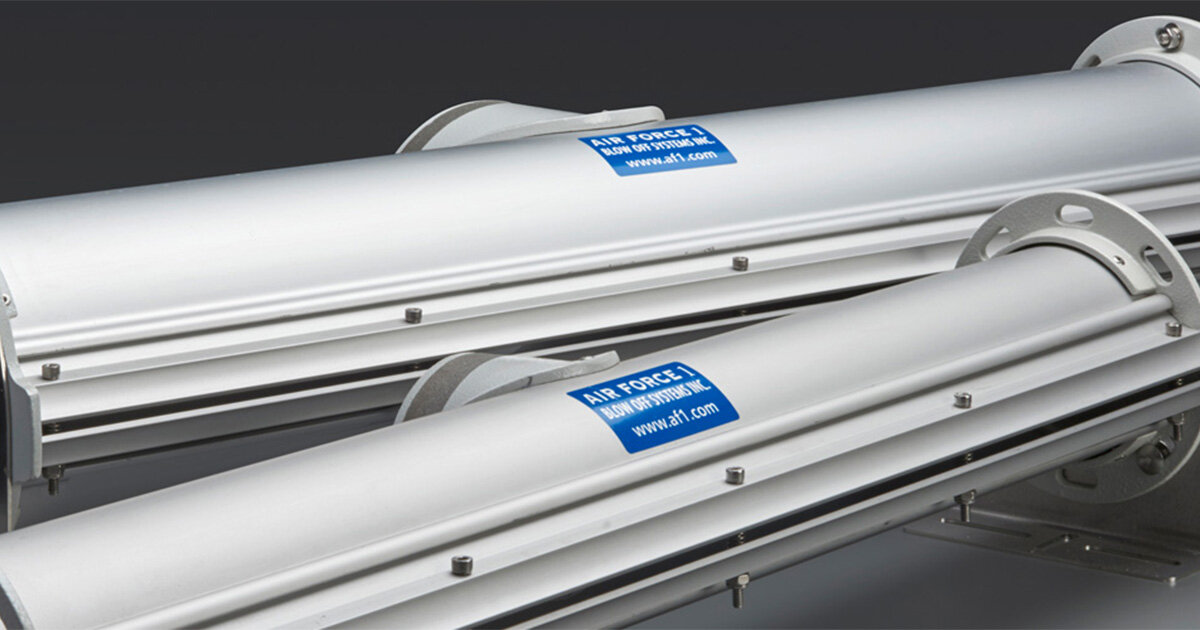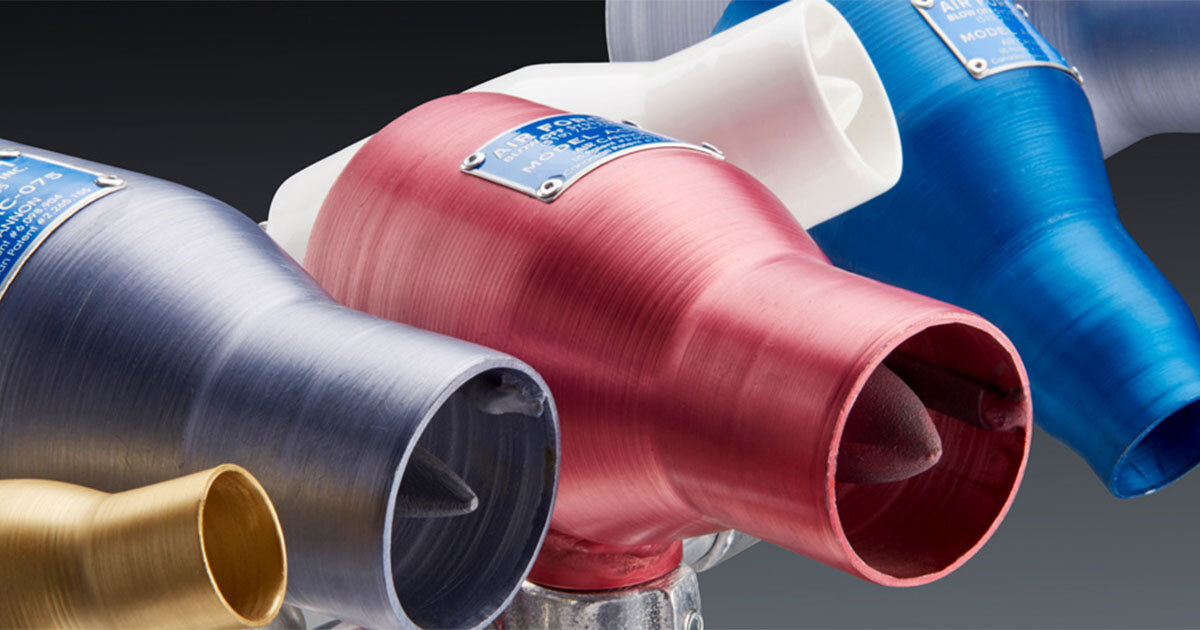
When it comes to industrial manufacturing, getting a spotless and streak-free finish on your final products is essential. Whether you're in the automotive, food processing, or electronics manufacturing industry – residual water can impact the overall quality issues and dissatisfied customers.
Luckily, there are systems available to treat this very issue, including air knives and air cannons.
Air Force 1 are experts in various blow off technologies tailored specifically to your industry’s needs. We have the tools to get the job done. Let’s explore.
What are Air Knives and Air Cannons?
So, we’ve introduced the tools, but what are they, and how do they work? If you read the names, you might picture some fantastical wind-powered weapons from a fairytale – but rather, they’re complex and efficient tools.
Air Knives
Air knives are specialized tools designed to generate a high-velocity, uniform sheet of air. Typically, they’re mounted across conveyor belts or production lines to blow away water, dust, and debris from the surfaces of products as they move down the line.
Anti-static bars are also easily combined with the air knives to help remove static charges. These anti-static bars can also be mounted inside the air knives for added protection from the process to prevent physical damages or debris buildup.

Air Cannons
Air cannons are a powerful tool that provide a high degree of impact. They’re typically used to dislodge materials and liquid or clean surfaces that are usually hard to reach with conventional methods. They can be combined together to provide both high impact and overall coverage of the parts being processed.

Industries and Various Implementations of Blow Off Systems
Several industries benefit from using these tools, and there are many more than even the three we mentioned. However, for the sake of brevity, we'll explore some of the common industries where these tools may be utilized to add some context:
Automotive Industry
In the automotive industry, the presence of water spots and streaks can impact the visual impact of the final product. Water spots, for example, on a freshly painted car body can cause imperfections in the finish, impacting its aesthetic appeal and potentially leading to a compromised product.
Residual water in crevices or hard-to-reach places can also cause rust and corrosion over time, compromising the vehicle's structural integrity and appearance.
The utilization of technology such as air knives or air cannons can help ensure that vehicles or their individual parts are completely dry before moving to the next essential stages of production, enhancing the appearance and durability of the vehicle.
Food Processing Industry
Food processing requires a great deal of hygiene and cleanliness to avoid potential contamination. Water spots and streaks on food products or packaging can show inadequate drying, leading to possible spoilage.
Residual moisture can create an environment that fosters bacterial growth, which can be a serious health risk to consumers. Air knives are an effective means of drying food products quickly and efficiently, ensuring that there isn’t any moisture left behind that compromises your food’s safety.
Food products such as fruits, vegetables, and packaged goods must be well maintained to preserve their shelf life.
Static and dust removal from packaging is important for the health and safety of the product.
Electronics Manufacturing Industry
The removal of dust and especially static charges is important in the process. Air knives or air cannons can be used to help remove both problems.
While you wouldn't expect there to be any moisture present in the process of manufacturing electronics, it does occasionally happen. However, if not properly managed, the presence of moisture can be consequential, leading to short circuits, corrosion, and other forms of damage.
For example, moisture on circuit boards can lead to electrical shorts, causing malfunctions or overall failure of the device. The use of high-velocity air can provide the precise drying required to ensure that electronic components are safe and dry.
The Elimination Water Spots and Streaks Using Blow Off Systems
There are many reasons why you’d want to use specialized air tools for drying during the manufacturing process. We’ve already mentioned some of the industries and possible applications in those manufacturing scenarios, but now we’re going to go through the perks and efficiencies of the tools.
Precision Drying
Air knives and air cannons offer precise control over the drying process, ensuring safe and effective drying in various scenarios. This high-velocity air effectively shears water from surfaces, leaving them dry and spot-free.
The air stream is emitted in a uniform way to ensure consistent drying—and consistency is essential for maintaining product quality, especially when it comes to the tools you use.
Unlike other methods, which could leave uneven, wet patches, these tools ensure the surface of your product (including hard-to-reach spots) is properly dried.
Efficiency and Speed
In fast-moving manufacturing environments, it’s essential to maintain that high speed and output. Tools such as air knives and air cannons can dry products much faster than other methods like absorbent materials.
The rapid drying process helps improve production efficiency while ensuring no remaining water forms water spots or streaks. By reducing drying time, product output is higher, allowing manufacturers to meet intense production schedules without having to compromise product quality.
Versatility and Adaptability
One of the significant advantages of air knives and air cannons is their versatility. They can be customized to fit various production lines and are effective on a wide range of materials, from metals to plastics to glass. This adaptability makes them suitable for different stages of the manufacturing process.
Whether drying large flat surfaces or intricate parts with complex geometries, these tools can be configured to deliver optimal performance.
Environmental and Cost Benefits
The utilization of air knives and air cannons can offer potentially significant cost savings. They reduce and sometimes even eliminate the need for disposable materials such as wipes and absorbent clothes while also minimizing the energy consumption that comes with heated drying methods – although heated methods have many benefits, too.
They also create a cleaner and safer working environment by reducing the presence of water on production floors, protecting manufacturer's employees from potential harm.
It's also important to look at the environmental benefit – by cutting down on waste and lowering energy usage, these tools can help manufacturers reach key sustainability goals and reduce their overall carbon footprint.
Implementation and Maintenance
It's essential to work with providers to assess the production line's specific needs and choose the right type of specialized equipment. Factors such as air pressure, flow rate, and nozzle design must be considered to ensure the highest performance.
Maintenance is also something that's important to consider. Ideally, you regularly inspect and clean the tools to ensure they're working at their highest capacity.
Over time, nozzles can occasionally become clogged with debris, reducing the impact of the air flow. Routine maintenance schedules can prevent these issues and extend the life of the equipment.
Air Force 1 Blow Off Systems offers the highest quality blow-off technology and can help pair you and your business with the right tools to help aid in your manufacturing process.
A History of Air Knives and Blow Off Systems
To truly understand the systems we’ve discussed today, we should explore a brief history – something we may delve deeper into later.
Originally referred to as “air doctors”, the very first iterations of the air knife were a successful invention developed in the 1950s, as their laminar airflow allowed the tool to blow off debris from products and control the thickness of liquids.
It was Willis Whitfield, an American physicist who realized there was a great need for sterile cleaning in nuclear research and developed the laminar-flow cleanroom back in 1959 to address the issue. It utilized air knife technology to create a solution that was nearly 1,000 times more effective than previous technologies.
By the 1960s and 1970s, industry professionals would move away from the air doctor origins of the modern-day air knives to develop the comprehensive tool we know today. Air knives were often used for blowing debris from objects, but advances in technology now allow them to be used in cooling and drying scenarios, too. These advances came along with the advancements in blower technology around the same time.
Today, there are hundreds of industries that rely on this technology to carry out their day-to-day operations. This is why Air Force 1 is a leading supplier of blow off system technology.
Air Force 1 Blow Off Systems - a Leader in the Industry
At Air Force 1, we take pride in manufacturing our line of non-sparking, corrosion-resistant blowers. These blowers are meticulously designed and sized to work seamlessly with our extensive range of stainless steel, hard-anodized air knives, and patented armor-coated or anodized air cannon nozzles.
Our commitment to quality and innovation ensures that our products stand up to the toughest environments and deliver exceptional performance.
At Air Force 1, our mission is to provide innovative, reliable, and efficient blow off systems that enhance your operational efficiency and product quality. Trust us to deliver the perfect solution for your unique requirements. Contact us today.

